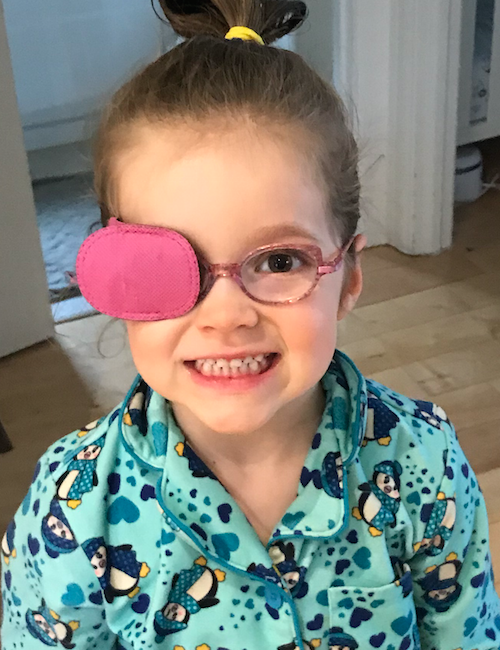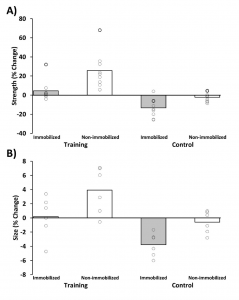How to get better faster after wearing a cast

This picture is my 4 year old daughter Maeve. At age 2 she spontaneously went a little cross-eyed, the same way that Mount Everest is a little hill. If we took that patch off, her left eye would make an immediate bee-line towards her nose.
It turns out she has significant weakness in a muscle that helps control the movement of her left eye.
The first line of treatment? Patching. She wears that patch at least an hour a day (unless we forget…..then she wears it 3-4 hours).
The basic premise is beautifully logical. Patch her strong eye, and force her weak eye to work harder, hopefully improving its strength over time.
There’s a similar premise in rehabilitation that is rarely used called ‘cross-education’.
Let’s pretend you break your right leg, and you are placed in a cast that keeps your leg immobilized in a completely straight position. Over time your quadriceps muscle on that side will get weaker and shrink because it is not being used.
Any of you that have had to wear a cast can attest to this. When the cast was mercifully removed, you likely remember being shocked at how much muscle you lost.
It has long been held that if you train the same muscle on the other side, you can offset some of these effects. So in our example, if over the 6 weeks that you are in the straight leg cast on the right, you strength train your LEFT quadriceps you will not lose as much muscle and you will retain more strength on that RIGHT side.
I distinctly remember learning this at school and being baffled by it. I could not reconcile how this could happen. A student challenged the professor on it, asking for a mechanism and the professor kind of shrugged it off saying it just happens and that’s all we need to know.
Well it turns out that smug professor was correct….it just took about 10 years for science to catch up and help quantify just how important cross education is.
Before we begin, we need to understand why you become weak and lose muscle when you have a body part immobilized.
We know that with immobilization the nervous system is heavily impacted in the early phase. Generally, when you are immobilized you lose significant strength over a very short period, but your muscle hasn’t really started to shrink yet. It’s just your nervous system becoming less and less efficient.
As science has caught up, there has been a few interesting observations regarding this. The most profound being that as you lose nervous system efficiency on the immobilized side, you actually GAIN efficiency on the non-immobilized side. This shows that there is intercommunication between the two sides after an injury and that the brain is able to adapt. Right side becomes far weaker, but your left side becomes slightly stronger. It’s like the old adage of losing a sense and the remaining senses strengthening.
From a muscle standpoint there is really nothing but bad news. A 2007 study showed a 0.5% decrease PER DAY over 21 days and a 50% decrease overall in muscle protein synthesis following lower limb immobilization. Essentially, the muscles engine slows to a putter. This results in a rapid decline in strength and muscle activation following immobilization.
So it is both the nervous system and the muscle system that are affected by immobilization.
So how do we fix this?
A 2018 review article grouped the only 5 studies published on cross education with a healthy non-immobilized limb and compared this to a control group that did not cross train.
What does this look like?

This picture does a good basic job to help us understand the effects. Figure A is the control group. The left arm is immobilized and the person is not doing any cross education with the right arm. Once the cast is removed, there is significant decrease in strength and muscle size (represented by the red arrow). Figure B sees the same situation, except this person did some cross education. This time, the right arm that was lifting weight throughout the immobilization got a lot stronger (that is why it is green like the Hulk after the cast is removed) and the arm that was in the cast looks surprisingly very much like it had before being placed in the cast (that is why it is a neutral yellow colour).
If you’re a math geek like me, you will want a fancy figure showing exactly how important cross education is. Well you’re in luck….see below.

Generally, when expressed as a percentage of loss, the muscle sparing effects of cross education showed an average of 4.6% IMPROVEMENT compared with -13.3% loss for the group that did not do the cross education. And for the arm that did the strength training? It got 26% stronger as well, compared to a 2.5% loss for the control group. And that is after just 3 weeks. It’s hard to get across just how important that is.
For the people that did the cross education, they will hit the ground running after their cast is removed. Their rehab process will be a breeze. They will get back to their pre-injury strength way faster and their total rehabilitation process will be far shorter.
You may think this only applies to people in casts but that is not true. There are similar studies showing benefits after significant ankle sprains, wrist sprains, even muscle tears. Realistically, for nearly any injury to one of your limbs, by working the same muscle group on the healthy side early, you will have a significant impact on your recovery.
So next time you are in clinic after a significantly rolled ankle on your right, don’t think we are crazy when we start you strength training your left in the first session.
